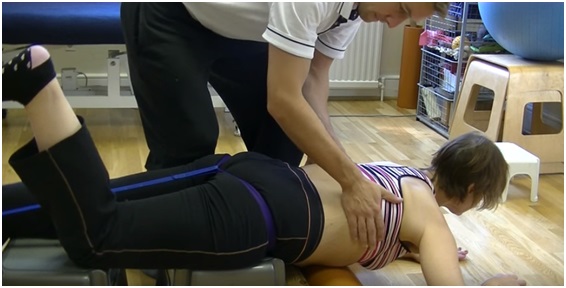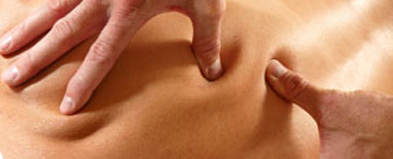Many discussions about
scoliosis - and the
treatment of scoliosis in particular - centre on something called the
Cobb angle. The Cobb angle is among the most important indicators of scoliosis severity, and
Cobb angle reduction is the primary goal of the non-surgical
scoliosis treatment courses we deliver here at Scoliosis SOS.
Simply put, the Cobb angle is just a way of measuring the curve of a scoliosis sufferer's spine. It is named after John Robert Cobb, an orthopaedic surgeon from the USA; Cobb was born in 1903, and he conducted extensive research into scoliosis when relatively little was known about the condition. He identified that only 1 in 10 scoliosis sufferers actually requires surgical treatment, and so he devised the Cobb angle as a straightforward means of determining whether or not a patient's spinal curvature is severe enough to necessitate surgery.
Cobb angle examples
The X-rays below show Cobb angle measurements for five different scoliosis sufferers (all of whom were treated here at the Scoliosis SOS Clinic). The patients' ages range from 7 to 32 years old.
More Cobb angle examples can be found
here.
Using the Cobb angle to assess treatment needs
Scoliosis can only be diagnosed (and its severity assessed) by an experienced practitioner. However, here is a rough guide to what the Cobb angle means:
- A Cobb angle of less than 10° is entirely normal - there is no such thing as a perfectly straight spine, and everyone will have some slight deviation in their spinal alignment.
- 10° is generally accepted as the threshold for determining if somebody has scoliosis. Scoliosis will not be given as a diagnosis unless the patient's Cobb angle is 10° or more.
- When the Cobb angle is between 20° and 40°, a back brace is usually recommended; back braces come in many different shapes and sizes, and some are worn only at night. However, some patients may be prescribed a brace at 15° or at 50° - it all depends on the hospital that's administering treatment.
- How large does a patient's Cobb angle need to be before an orthopaedic surgeon will recommend surgery? The answer varies from country to country and is often influenced by whether the patient is already wearing a brace and/or undergoing scoliosis-specific physiotherapy. In the UK, the threshold is often 40°; in continental Europe, it's more frequently 50°.
- 12° to 120°: This is the range of Cobb angles we treat using our ScolioGold therapy programme (although the majority of our patients exhibit curves of between 20° and 65°).
Click below to see how our treatment courses can help to reduce the Cobb angle or contact us now to book an initial consultation for yourself or a family member.
Scoliosis can be caused by a variety of
different factors, but the condition's most common form is
idiopathic scoliosis. Idiopathic scoliosis has no known cause, but it usually develops during adolescence and - interestingly - it is far more common in girls than in boys. Furthermore, there is some evidence to suggest that scoliosis tends to be more progressive in female patients than in their male counterparts.
So why should idiopathic scoliosis affect women more often (and more severely) than it affects men? As with the question of what causes scoliosis in the first place, science has yet to discover a solid answer to this mystery. However, we have seen a number of theories proposed - here's one of the more plausible suggestions:
It may be linked to patients' leptin levels
Leptin is a hormone that performs many different tasks in the human body. One of its best-known functions is appetite suppression; a hormone called ghrelin tells you when you need to eat, and leptin tells you when it's time to stop.
However, leptin seems to have many other effects beyond simply making you feel full. The hormone has been shown to affect bone growth in mice via the SNS (Sympathetic Nervous System), and
it has been suggested that idiopathic scoliosis in females may occur as a result of "increased SNS activity" that also affects the patient's weight (girls with scoliosis tend to have a fairly low BMI).
However, it is important to note that this is merely a hypothesis; as stated above, there is no concrete, scientifically proven explanation for the high incidence of scoliosis in females compared to males. It's equally important to bear in mind that we treat a diverse cross-section of patients here at the Scoliosis SOS Clinic, and while the majority of our patients are female, we can help men to overcome the effects of scoliosis as well. Kurt, a 29-year-old man who travelled to our clinic from California last year, is a prime example:
Click here for more video testimonials from our previous patients, or contact us now if you'd like to arrange a consultation at the Scoliosis SOS Clinic.
While scoliosis is a condition that usually arises during adolescence, we know from our years of experience and the research we have conducted that scoliosis often causes a great deal of discomfort and pain in adults as well as in younger patients. As the condition is most discussed in terms of adolescent patients, we wanted to discuss how scoliosis in adults is treated.

Older individuals are most commonly affected by two specific types of scoliosis: idiopathic scoliosis and adult degenerative scoliosis. Here’s a little more information on both scoliosis conditions that effect adults:
Idiopathic Scoliosis
This form of scoliosis is a continuation of the condition in its adolescent form, which may have progressed due to it being left untreated previously. The extent of the spinal curve may have increased over time, particularly for those with a curve of 40° or more. For this reason, it is highly important for individuals with this form of scoliosis to monitor the extent of their curve, as it often leads to further damage and discomfort over time.
Adult Degenerative Scoliosis
Unlike adolescent scoliosis, this form of the condition arises in adulthood due to a degeneration of the discs, as well as arthritis of the facet joints and a collapse of the disc spaces. It is normally most apparent in the lower spine, and can therefore cause pain and numbness not only in the back itself, but also in the legs.
How Can We Help?
Although these forms of scoliosis may differ slightly from their adolescent counterparts, the non-invasive treatment programmes offered by Scoliosis SOS are still able to provide relief from the pain and aesthetic distortions suffered by adult patients, even in more severe cases.
See how we helped Eileen, a 58-year-old patient who needed help with her scoliosis in adulthood:
We are proud to say that our patients, regardless of their age and the extent of their deformity, consistently report substantial improvements in their wellbeing and appearance after receiving our treatments. Patients also continue to see positive progress after completing their course by performing our tailored exercise programmes at home. Scoliosis in adults can be treated without surgery, and we are more than happy to discuss your options with you.
If you suspect that you may be suffering with scoliosis, please feel free to get in touch with Scoliosis SOS to learn more about our treatment approach and to find out how we can help you.

Trigger point therapy is an increasingly popular means of treating musculoskeletal pain. If you suffer from pain as a result of scoliosis, hyperkyphosis, or a similar spinal condition, then trigger point therapy may be able to help alleviate some of your symptoms – here's a little more information about this method:
What is trigger point therapy?
Trigger point therapy was devised in the USA in the early 1940s. The technique, which was greatly influenced by the findings of physician and medical researcher Janet Travell, is based on the idea that most musculoskeletal pain can be traced to a specific source or 'trigger point'.
When administering trigger point therapy, a physiotherapist will aim to locate their patient's trigger point(s) and use targeted massage techniques to relieve that patient's pain.
Is trigger point therapy effective?
While trigger points as a concept are still somewhat controversial, studies (reported in Myofascial Pain and Dysfunction: The Trigger Point Manual by David G. Simons, Janet G. Travell and Lois S. Simons) have shown that roughly three-quarters of pain clinic patients "have a trigger point as the sole source of their pain".
While we do not believe that trigger point therapy alone is an effective treatment for scoliosis and similar musculoskeletal conditions, we have found that the technique often helps to relieve the pain endured by those who suffer from such conditions.
Does the Scoliosis SOS Clinic use trigger point therapy?
Yes – trigger point therapy is one of the many therapeutic approaches that we incorporate into our ScolioGold treatment courses. Our physiotherapists use this method (along with other techniques like taping and osteopathy) to reduce pain, while techniques such as the Schroth method are utilised to correct the patient's posture and improve their mobility.
Please click here to learn more about our scoliosis treatment courses, or contact Scoliosis SOS today to book an initial consultation with our scoliosis specialists.